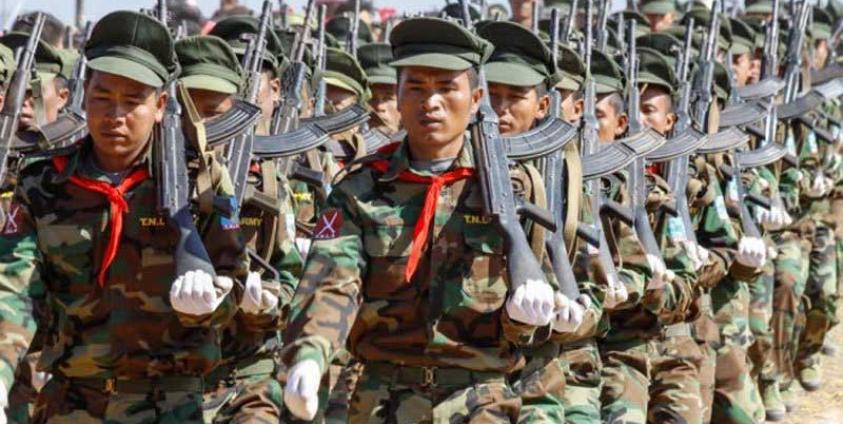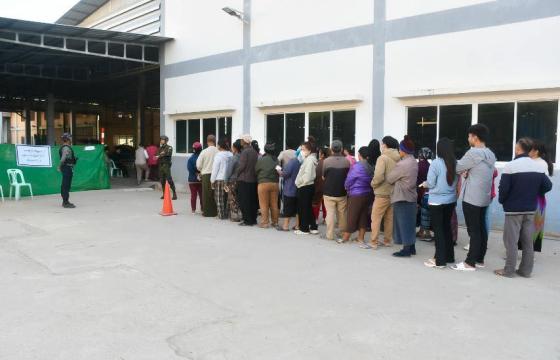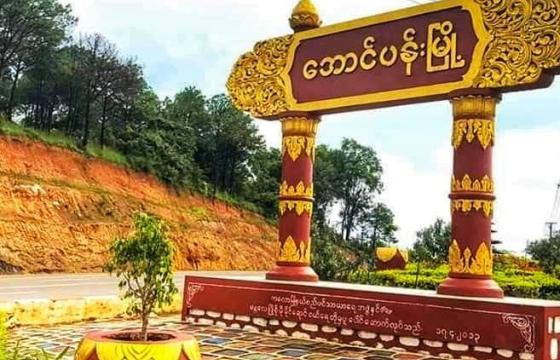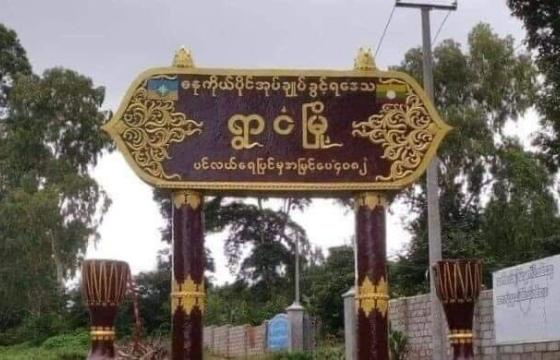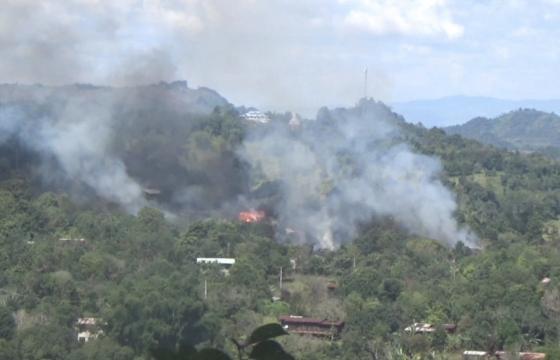As the year ends, protracted ethnic conflict has expanded into the Rakhine State. The Arakan Army (AA), a new outfit that was formed only in 2009, has serious armed clashes with the Military or Tatmadaw from the end of November and well into the first week of December leaving casualties on both sides during the fighting.
There has also been heightened inter-ethnic conflict within Shan State, which started three years ago in November 2015 in the aftermath of the Nationwide Ceasefire Agreement (NCA) signing. Small scattered skirmishes intensified, as the Shan State Progress Party/Shan State Army (SSPP/SSA) joined in the fray alongside the Ta’ang National Liberation Army (TNLA) side to route out the Restoration Council of Shan State/Shan State Army (RCSS/SSA). And for the first time in ethnic resistance history, a large-scale war of inter-ethnic conflict began, both sides employing hundred of troops. This has pitted Palaung or Ta’ang against Shan and also Shan against Shan, as both RCSS and SSPP are Shan armies, the former originally based in the south along with the Thai border and the latter based in the north with headquarters in central Shan State, Wanhai.
By all accounts, these protracted war of expansion into other ethnic states, such as Chin and Arakan, and the large-scale inter-ethnic war in northern Shan State are not conducive to peace-making and reconciliation and it looks like the two conflicts will be carried on into next year and beyond.
Ethnic armed conflict actors and alliances
Like in the past, many ethnic armed alliances previously formed now belong in history, with the exception of United Nationalities Federal Council (UNFC) which is now on the brink of total disintegration, as the once strong 11-party member alliance formed in 2011 now only has two members left, the Karenni People Progressive Party (KNPP), well looked up for its steadfast political principle adherence with few hundreds troops and the Arakan National Council (ANC), politically well respected but with just a few dozens troops based in Karen State.
Generally speaking, ethnic armed alliances can now be divided into just two. One is the Federal Political Negotiation and Consultative Committee (FPNCC) headed by the United Wa State Army (UWSA) and the other, the Nationwide Ceasefire Agreement – Signatories, Ethnic Armed Organizations (NCA-S-EAO).
The New Mon State Party (NMSP) and the Lahu Democratic Union (LDU) signed the nationwide ceasefire agreement (NCA) on 13 February 2018 and joined the original 8 NCA-signatories. These ten groups collectively known as NCA-S EAO are: All Burma Students’ Democratic Front (ABSDF); Arakan Liberation Party (ALP); Chin National Front (CNF); Democratic Karen Benevolent Army (DKBA); Karen National Union (KNU); KNU/Karen National Liberation Army – Peace Council (KNU/KNLA-PC); Pa-O National Liberation Organization (PNLO); Restoration Council of Shan State (RCSS); New Mon State Party (NMSP); and Lahu Democratic Union (LDU).
Members of the FPNCC, also popularly known as Pangkham (or Panghsang) alliance are Kachin Independence Organization/Army (KIO/KIA), National Democratic Alliance Army (NDAA), Shan State Progress Party/Shan State Army (SSPP/SSA), Palaung State Liberation Front/Ta’ang National Liberation Army (PSLF/TNLA), Myanmar National Democratic Army (MNDAA), Arakan Army (AA), and the United Wa State Army.
The National Socialist Council of Nagaland-Khaplang (NSCN-K) is not involved in any ethnic armed group alliance.
Conflict data and situation in ethnic states
Generally, the Kachin and the northern Shan States are the primary contested areas with the highest armed engagement count, followed by medium conflict count in Karen State and to a lesser extent the Arakan and Chin States. Karenni and Mon States are almost conflict-free, with just one skirmish in the former and none in the latter for the year.
Available data from January to September for the year 2018 from Myanmar Institute for Peace band Security website based inside the country showed 486 armed incidents.
The breakdown in months are: January 44+10=54; February 26+28=54; March 65+21=86; April 53+20=73; May 92+17=109 June 13+4=17; July 27+2=29; August 25+4=29; September 27+8=35. The first figures are actual armed clashes, while the ones that follow are Improvised Explosive Device (IED) related clashes.
The same conflict research institute updated the conflict occurrence for the year 2018 from January to November as 584, including IED attacks. Inter-ethnic armed clashes are registered as 83.
A KIA Military Intelligence source listed the number of armed clashes between its army and the Tatmadaw as 245, including IED attacks, for the year 2018 which was counted from January to October.
The data from KIA source also made known the number of armed clashes that occurred between itself and the Tatmadaw when the 17 years of ceasefire broke down in the year 2011 and continue up to the present. They are: 2011 (June-Dec) 663; 2012 (Jan-Dec) 879; 2013 (Jan-Dec) 224; 2014 (Jan-Dec) 155; 2015 (Jan-Dec) 634; 2016 (Jan-Dec) 741; 2017 (Jan-Dec) 361; 2018 (Jan-Oct 15) 245.
Apart from the two direct sources secondary media sources also reported as below on specific two EAOs armed engagement count corresponding to the contested areas.
The AA spokesman Khaing Thu Kha told The Irrawaddy on December 5 roughly that armed clashes occurred between 20 to 30 time with the Tatmadaw for the year.
The KNU was said to be engaged in skirmishes with the Tatmadaw 57 times during the year mostly in Papun (Mutraw) of in its Brigade 5 area.
Kachin and Shan States
The Kachin and Shan States emerged as main contested battlegrounds as the ceasefire between the KIA and the Tatmadaw collapsed in 2011, followed by the MNDAA attack on government positions in 2015 in Kokang, northern Shan State, to regain back its stronghold evicted by its rival group backed and aided by the Tatmadaw. The MNDAA wasn’t able to achieve its objective but since then has battled the Tatmadaw together with the Northern Alliance – Burma (NA-B), a military front comprised of AA, TNLA, KIA and itself.
The inter-ethnic conflict has been going on between the RCSS and TNLA ever since 2015 and recently this year the SSPP joined to combat the latter.
Another inter-ethnic conflict occurred between the PNLO and RCSS in mid-October twice. The two clashes occurred at Loi Kawng Muu, near Wan Meik Pok village in Mong Pang’s Nermoon village tract over a territorial dispute.
There had been casualties on both sides but the exact number of deaths is not known.
The war in the northern Shan States covering Muse, Namkham, Kokang, Namtu, Hsipaw, Lashio and Kyaukme Townships have been on and off, sometimes intensive and at times low key ever since 2015.
Kayah or Karenni State
On 20 October the Tatmadaw and KNPP clashed once for the first time since the two sides signed a ceasefire in 2012, but no one was injured.
The KNPP said the Tatmadaw’s Light Infantry Brigade (LIB) 428, based in Mawchi Township, travelled to a KNPP-controlled area to conduct the operation but did not use a regular, designated route agreed to in 2013. This use of a non-designated route triggered the clash, according to the KNPP. However, the Tatmadaw said KNPP seven-member team attacked its troops a day earlier between Nan Kit and Ba Han Lot villages in Hpa Saung Township.
KNPP hasn’t signed the NCA even though negotiations have been ongoing since 2015.
Mon State
Tatmadaw and its subdivision Border Guard Force (BGF) occupied a New Mon State Party (NMSP) outpost situated in the village of Kanalou in Mon State’s Kyaikmayaw at the end of June. The NMSP took down their flag and handed it over to the village administrator and withdrew accordingly without confrontation. Reportedly, the NMSP was instructed not to operate and occupy the outpost. Other than that no open conflict has been reported.
Karen State
The KNU, the most friendly EAO with good working relationship with the Tatmadaw’s Commander-in-Chief, found itself in confrontation as frequent military tensions developed between the Myanmar Army and KNLA Brigade 5, due to the Tatmadaw’s deployment of its troops in March and roadwork in Luthaw Township, an area controlled by the Karen National Liberation Army (KNLA), armed wing of the KNU, in Papun District. Resultant clashes between the military and KNLA forced more than 3,000 locals from their homes.
The two clashed again in July in Papun during the third session of the 21st Century Panglong Peace Conference in Naypyitaw.
Lately, following its conference from November 26 to December 1, the KNU’s Toungoo District chapter issued a statement expressing concerns over the Tatmadaw’s building of a road linking Papun, Nyaunglaybin, Toungoo and Thaton districts. The KNU is convinced that the road is intended for military purposes and that the local people also have concerns about it.
So far, the KNU has already clashed nearly 60 times starting from March and if more road-building inside its controlled areas is started the armed conflict will likely widen.
Arakan and Chin States
Armed clashes occurred 20 to 30 times between the AA and the Tatmadaw during the year around Paletwa in Chin State and Buthidaung and Rathaedaung Townships of Arakan State.
The latest skirmishes from the end of November until well into the first week of December were said to be heavy and both sides have seen casualties. Reportedly, clashes began after AA troops ambushed a military column conducting “area clearing” operations near the Myanmar-Bangladesh border.
Over a dozen Tatmadaw troops, including officers, were said to have died and many wounded, while the AA was said to also suffer 4 killed in action.
Sagaing Region
An altercation was said to have taken place between the NSCN-K and Tatmadaw in Sagaing Division now renamed Sagaing Region at the end of July. No casualties were reported in the incident.
NSCN(K) functionaries said the ‘altercation’ with the Myanmar Army was triggered over a check-point of the rebel group near a Buddhist monastery at Taga in Hukwang Valley where its central headquarters is located.
Outlook and perspective
Given that the stark upsurge of inter-ethnic conflict this year in Shan State and the expansion of internal conflict, ongoing since 2011 and heightened in 2015, into Arakan and Chin States, it seems the war will go on for the unforeseeable future.
But still, it is the responsibility of all stakeholders to end this tragedy, as this reignited ethnic conflict is ruining everyone involved and is costly in terms of material and the human toll. The longer the war goes on the less possibility there is of the country freeing itself from the misery it is in.
To be able to ward off continued ethnic conflict the powers that be in Naypyitaw will have to take into account three approaches.
Firstly, the government needs to accept universal human rights norms, so that international condemnation, that has its roots in suppression and occupation of ethnic and religious others countrywide, is removed and stagnated investment climate improved, which in turn might make it possible to move away from the sole reliance on China, whether be it in the UNSC or economic well-being of the country.
Secondly, the government declares a unilateral ceasefire and stop all offensives in all ethnic states, to restart new trust and confidence-building to move the stalled peace process forward.
Thirdly, it needs to change the mindset of the government and Military leaders to abandon Bamar ethnocentrism vis-a-vis the non-Bamar ethnic nationalities and conduct all-inclusive political settlement negotiations without precondition on a level playing field.
Without the broad three minimum requirements mentioned being taken seriously into account, the prospect of ending ethnic armed conflict soon is hard to imagine.


